
This glossary of terms contains common building science terminology to better understand the content presented on the Effective R tool. In addition to the short descriptions shown below, you can click on the term to see a more detailed explanation.

This glossary of terms contains common building science terminology to better understand the content presented on the Effective R tool. In addition to the short descriptions shown below, you can click on the term to see a more detailed explanation.
An approach to wood framing that closely matches, and minimizes, the amount of wood used for framing to meet structural and finishing needs. Advanced framing may include locating studs on 600 mm centers, aligning studs, joists and roof trusses to limit the need for double plates and reinforcing jack studs, two-stud corners, lateral bracing, etc.
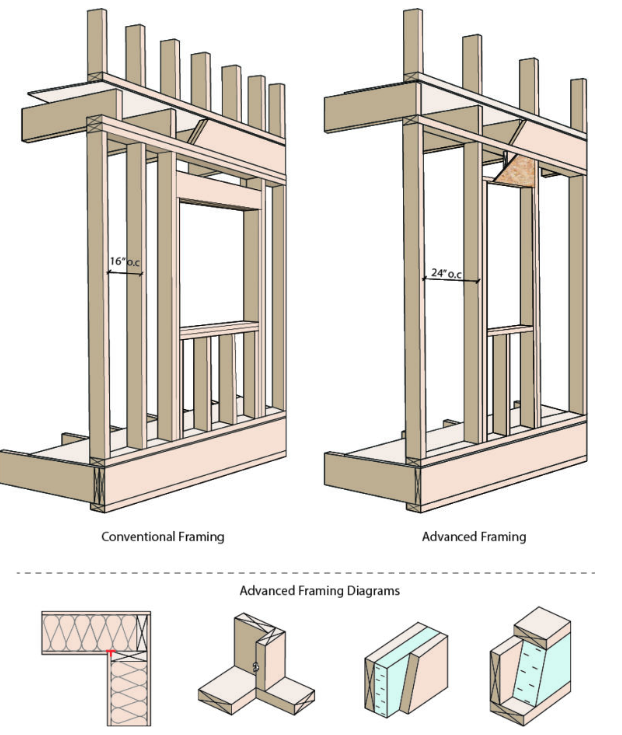
Application: Advanced framing is a technique that can be used to create a structurally sound building that has lower material and labour costs than a conventional wood-frame building. This can also extend to the additional cost savings related to less material waste that would need to be disposed of. Advanced framing can reduce the amount of wood used in construction often reducing thermal bridging and improving energy efficiency.
A component within the building assembly which restricts the passage of air. A combination of durable, structurally supported materials that are incorporated into the building envelope, continuous around the interior conditioned volume of the building (inclusive of ceiling, exterior walls, windows, doors, foundation walls and floors), and sealed together to prevent the leakage of air.
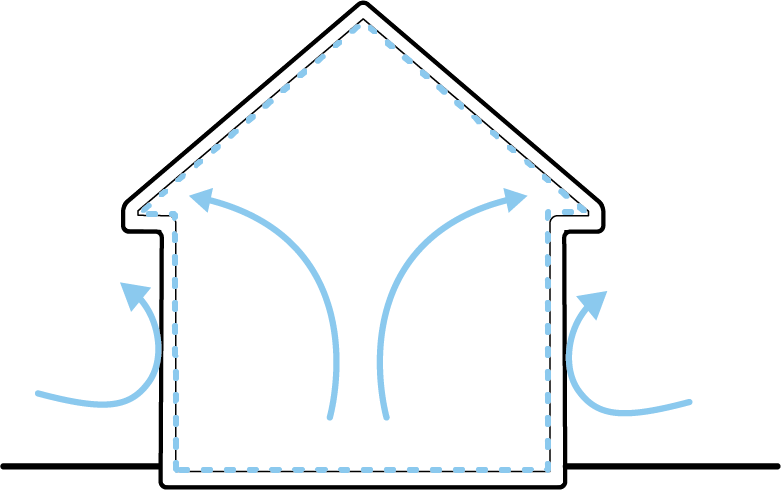
Application: Air barriers are primarily used to reduce air leakage or drafts in buildings. Reducing air leakage in buildings is critical to reducing moisture laden air from entering the building enclosure. Air carries moisture and is one of the primary modes where moisture can enter a wall assembly. Air barriers restrict the air, and the moisture carried by it, from entering the envelope.
The number of times the total volume of air within a room or an entire building is exchanged by either natural or mechanical means (usually measured in air changes per hour, ACH).
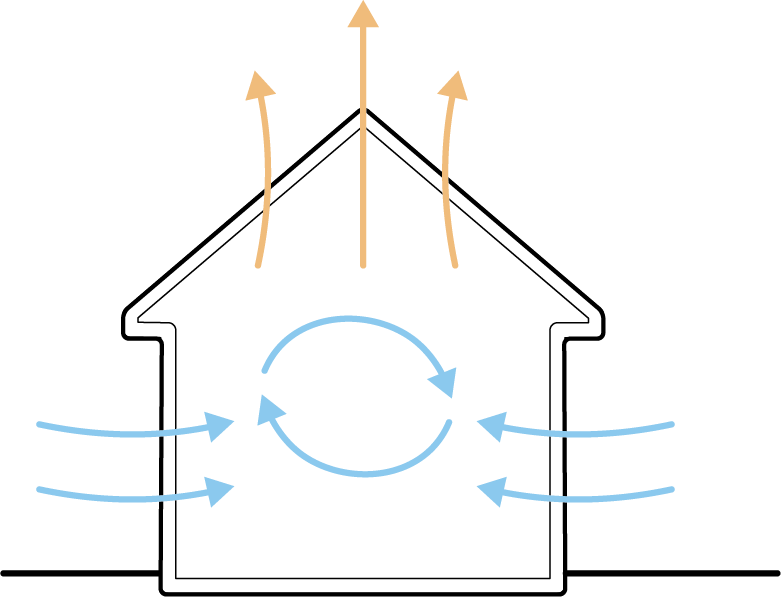
Application: Air change rate is a way to measure how airtight your building envelope is. It provides a tangible value to help understand the air leakage openings in the envelope. Lower air change rates are associated with more energy efficient buildings, because it means that less air is leaking through the assembly. The implication for mechanical system is that they may not need to work as hard to condition the interior air of the building.
The uncontrolled flow of air through a building envelope or a component of a building envelope as a result of a pressure difference.
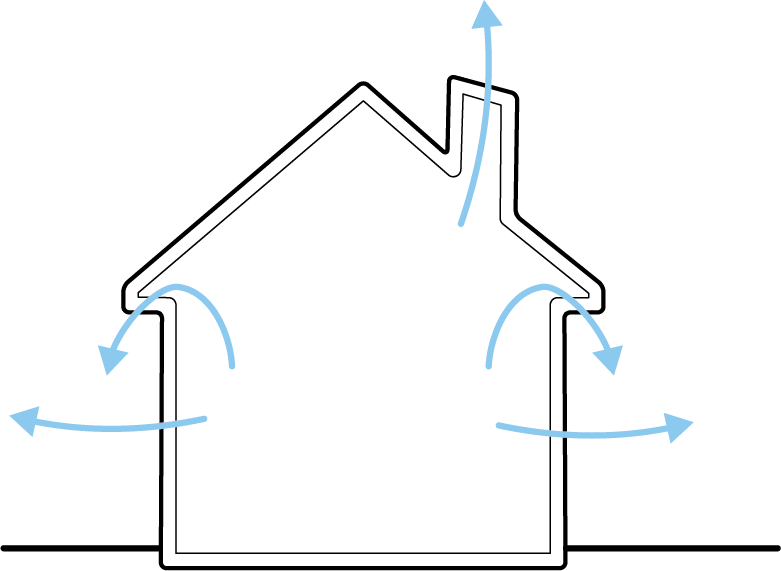
Application: It’s important to pay attention to air leakage in a building for a number of reasons. Uncontrolled air leakage can lead to moisture problems in a building. For example, if warm moist air is leaking into a cold attic space, it can lead to the build up moisture, ice and eventually mould. Additionally, from an energy efficiency perspective, a leaky building will require more energy to keep warm in the winter and cool in the summer.
The process of sealing penetrations, connections and joints in a building envelope to restrict air leakage into or through an assembly.
Application: Air sealing is a good way to reduce the air leakage of an assembly and lower the overall air change rate associated with it. Penetrations are commonly sealed with caulking, tape, or aerosolized sealant.
The ability of the building envelope, or a component of the building envelope, to resist air leakage.

A common building material that is often applied as a non-structural veneer to clad wall assemblies. Brick is a porous, absorptive material.
Read more about brick here.
The building’s shell, comprised of all components that separate conditioned space from unconditioned space including all structural components. Also referred to as the climate separator or the building assembly.
A sheet material used as a sheathing membrane within the building envelope to reduce air infiltration and water ingress. It consists of a heavy paper, usually impregnated with bitumen. Building paper is typically applied inboard of exterior finish materials in wood-frame construction. This material is not permeable to liquid water; however, it is relatively permeable (greater than 60 ng/Pa.s.m2) to water vapour. So, when it is installed on the outside of the assembly, it resists the ingress of rainwater but does not significantly impede the outward drying of the assembly.
You can read more about Building Paper here.
Moisture that it is built into the assembly when wet materials or components are used at the time of construction. (E.g. concrete used in foundations and basement slabs).
Application: Built in construction moisture must be considered when assessing the drying potential of the assembly. Fresh concrete has a significant volume of built in moisture. Concrete needs to remain damp while the Portland cement in the concrete mix goes through the curing or hydration process. After the curing process is complete, the concrete will take time to properly dry out of the building. Adding components that restrict drying may cause moisture problems within the assembly.
The movement of water through porous materials due to the forces of surface tension, adhesion and cohesion which pulls water up through the pores of a material.
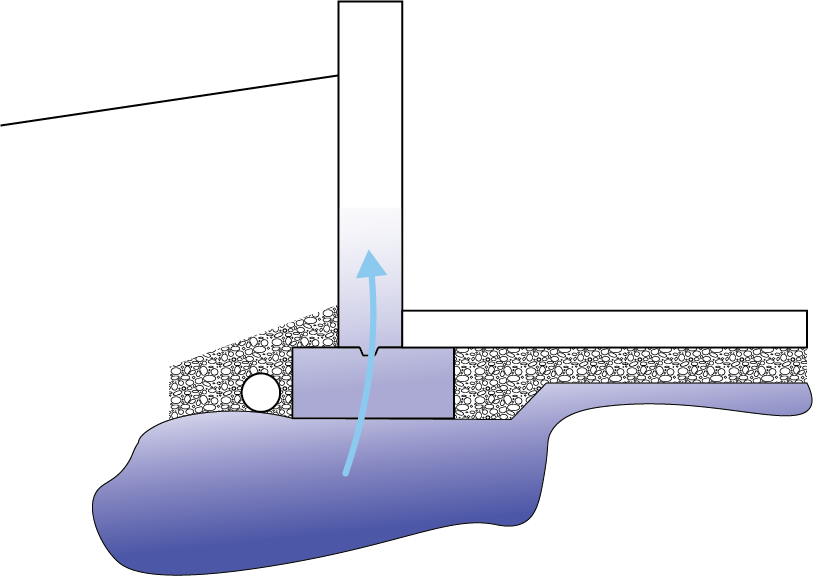
The insulating material that fills the spaces between studs within a wall assembly.
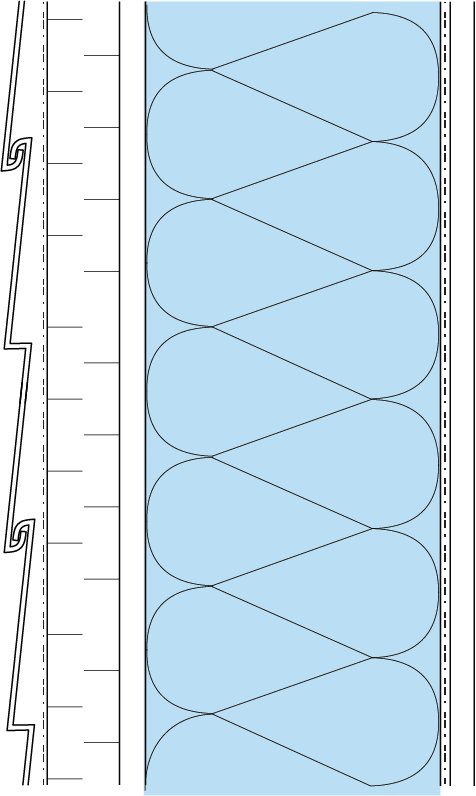
The thermal resistance of an assembly calculated through the centre of a wall cavity ignoring the effects of framing (thermal bridging). The thermal resistance of each of the components of the assembly are added together without taking into account the thermal resistance of the framing material. Thermal resistance indicates the ability of a material to resist heat transfer and is often used to characterize insulation materials.
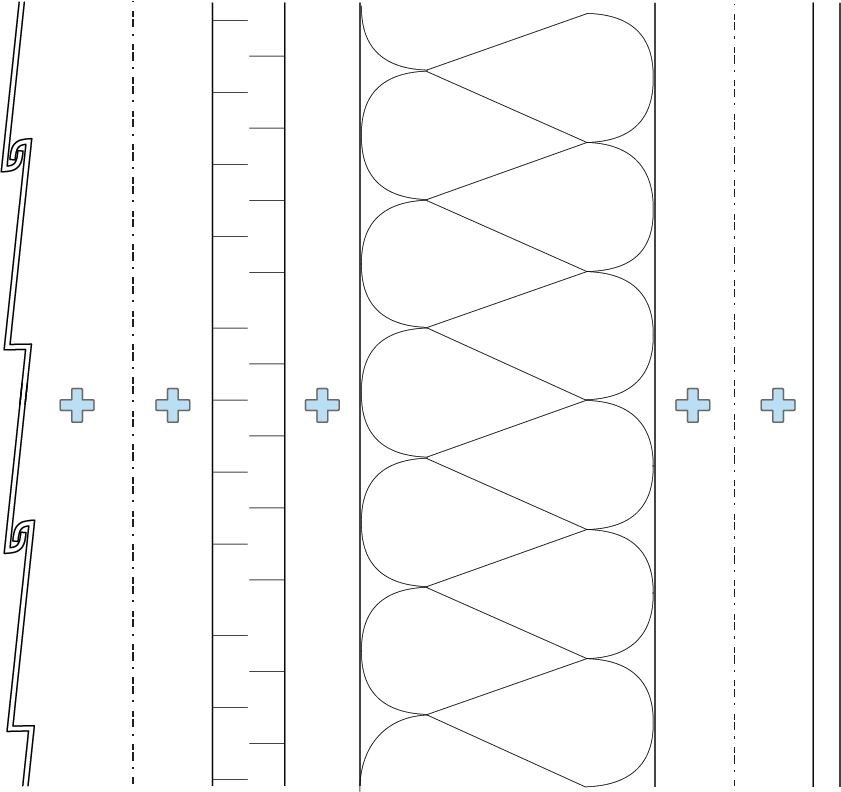
Climate zones are geographic areas that have been grouped together because they have similar climates, specifically in terms of temperature and moisture. Climate zones influence how assemblies are built, particularly in relation to thermal insulation and measures to control moisture.
An insulating material made from polyurethane that is sprayed to a building assembly. Closed cell spray foam consists of an insulating gas that is retained because it is completely encapsulated in the polyurethane. The resulting foam is rigid and dense, typically higher in density than an open cell spray foam, and lower in water vapour permeability.
Liquid water that results from the change in phase from water vapour to liquid.
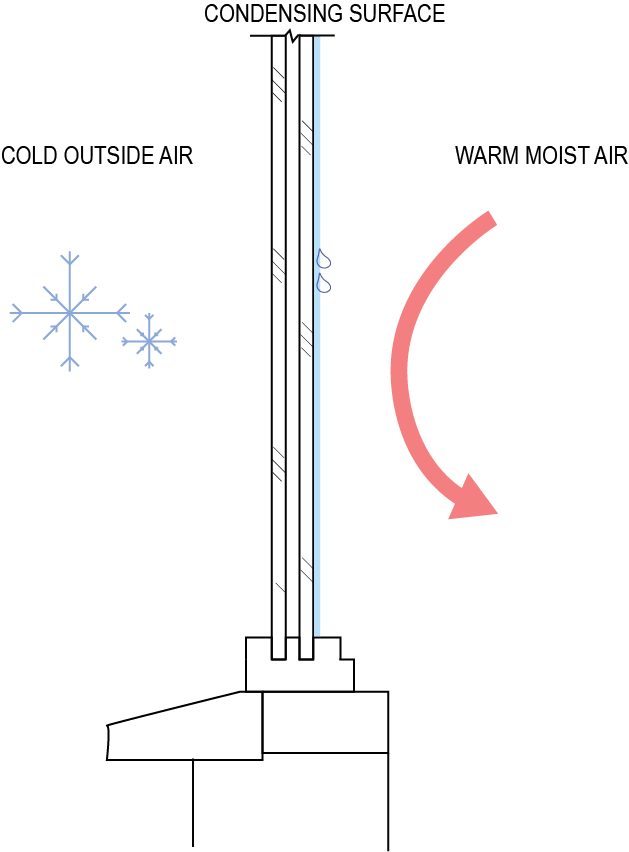
Insulation that is continuous across all structural members reducing the effects of thermal bridging. It can be installed on any opaque surface on the exterior of the building envelope.
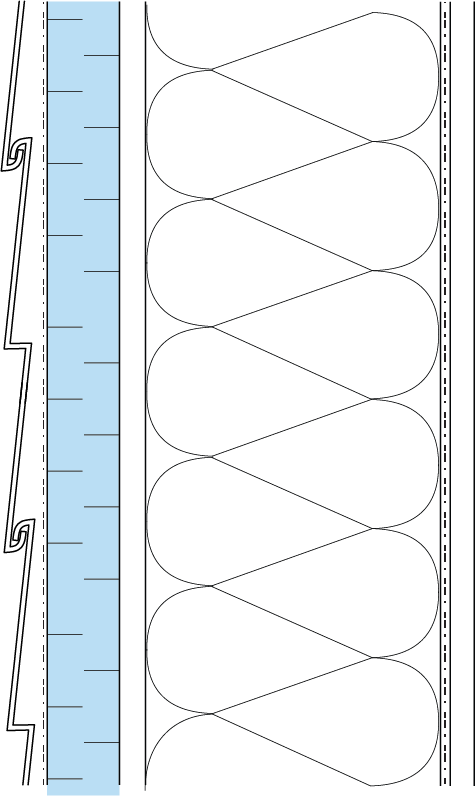
Read more about Continuous Exterior Insulation here.
An engineered wood product that includes alternating layers of flat-laid, dried lumber sometimes glued together edge to edge, and then glued layer on top of layer. These panels consist of 3, 5, 7, or 9 alternating layers of lumber. Common uses of CLT panels in mass timber construction are for walls and floor/ceiling assemblies.
You can read more about Cross Laminated Timber here.
The degree day is a calculated climate statistic used to characterise how severe the climate is for a specific geographic location. It is determined by calculating the difference in temperature between the outdoor mean temperature over a 24-hour period and a given base temperature. Primarily, degree days are used as a measure of yearly heating requirements, using a daily mean temperature from 18°C. The 18°C base temperature is determined based on the assumption that a building will not require heating until the outdoor mean temperature falls below that temperature.
Application: Degree Days are extremely useful when determining the heating requirements of a building. Sometimes they are used to help identify building envelope requirements. Degree days can help to determine how much a house in a certain location might have to pay for heating or cooling compared to a similar house in a different climate area. For example: If Salmon Arm, BC has about 4000 heating degree days and Thompson, Manitoba has about 7600 heating degree days, the same house in Thompson, Manitoba would cost about double as much to heat as the house in Salmon Arm, because it has about double the amount of heating degree days.
A densely packed, glass fibre insulation that can be installed into attic spaces, walls, and other areas. It can be used as an alternative for batt insulation in both new construction and retrofit applications.
A blown-in insulation material that is packed into the wall cavity until it achieves its required density. Cellulose, a paper-based material, has been chemically modified to provide fire, fungal, and corrosion resistance.
Various mechanisms that contribute to the deterioration and degradation of building materials, components, or assemblies. Deterioration mechanisms can include: moisture, insects, rot, etc...
Walls that consist of two parallel wall frames, often with a gap in between and attached to one another to create an extra thick wall with high thermal performance.
You can read more about Double Stud Walls here.
Drainage planes are any surface or material layer in the building envelope/enclosure made from water repellent materials (building paper, house wrap, sheet membranes, etc.…) that are located behind the cladding and are designed and constructed to intercept and drain rain water that passes through the cladding.
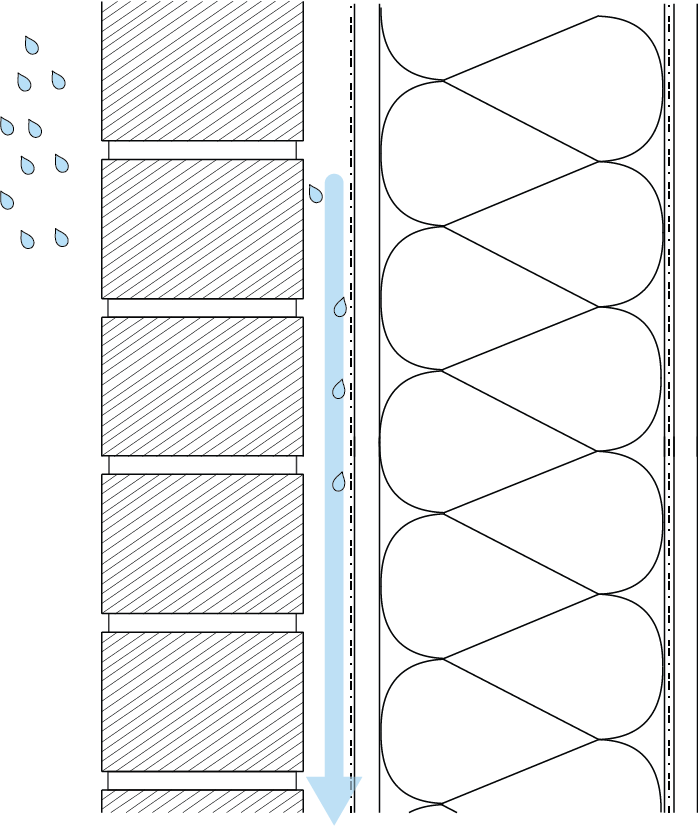
Drying potential is a measure of the ability for moisture in an assembly to dry effectively either to the inside and/or to the outside. Assemblies that get wet and that are able to dry are generally more durable and are considered to have a high drying potential.
The temperature at which a given air/water vapour mixture becomes saturated with water vapour (that is, 100 per cent relative humidity). This is the temperature a given air/water vapour mixture can be cooled to, at which point the vapour in the air begins to condense, going through a phase change from gas to liquid.

Application: A homeowner might experience condensation on the inside surface of their windows during the winter months. When the window temperature is below the dewpoint temperature of the interior air (at that humidity level), condensation will form on the window. The dewpoint temperature may be reduced by lowering the humidity level of the indoor air.
Effective R Value represents the effective thermal resistance of the assembly accounting for continuous insulation layers, framing members, cavity insulation, sheathing, interior and exterior finishes, air spaces, surface air films, and any other material within the assembly. The effective R value is a more accurate representation of the actual thermal resistance of the assembly when compared to the nominal R value. This is because the effective R value accounts for the heat loss/flow resulting from all the materials within the assembly. The effective R value is calculated by adding the RSI values of all the materials in the assembly together while considering the actual framing configuration since framing material has a lower thermal resistance than insulation and contributes to thermal bridging.
EIFS are a non-load bearing composite cladding system. They are composed of a water-resistant barrier (often liquid applied) over a substrate. An insulation board, which is often either attached with adhesive and/or mechanically to the substrate. Over the insulation an integrally reinforced base coat with a textured protective finish coat is applied. EIFS provide a continuous layer of insulation across the exterior wall surfaces, which significantly minimizes the instances of thermal bridging and increases the effective R-value of the assembly.
EIFS create an appearance that resembles stucco. While some may believe that EIFS and stucco are similar cladding systems, EIFS differ from stucco in many respects. EIFS are proprietary systems that rely upon the constituent components to interact and perform as a composite system. The primary difference is that in EIFS, the thermal insulation supports the base coat with an integral glass fibre reinforcing mesh. This differs from conventional stucco, where the reinforcement/metal lath is the supporting element of the stucco.
You can read more about EIFS here.
An insulation board formed from bonded, polystyrene beads. EPS, often referred to as beadboard, is a rigid, lightweight, closed-cell insulation material.
Read more about Expanded Polystyrene Insulation here.
Exterior Air Spaces are typically installed behind the cladding. These spaces are key components in managing rainwater. The space acts as a drainage plane for any bulk water that makes it past the cladding. Rain that makes it past the cladding and enters the assembly, typically will drain down the back of the cladding. In some cases, where the rain bridges the gap, it drains down the water resistive barrier in the assembly, preventing it from getting to the interior.
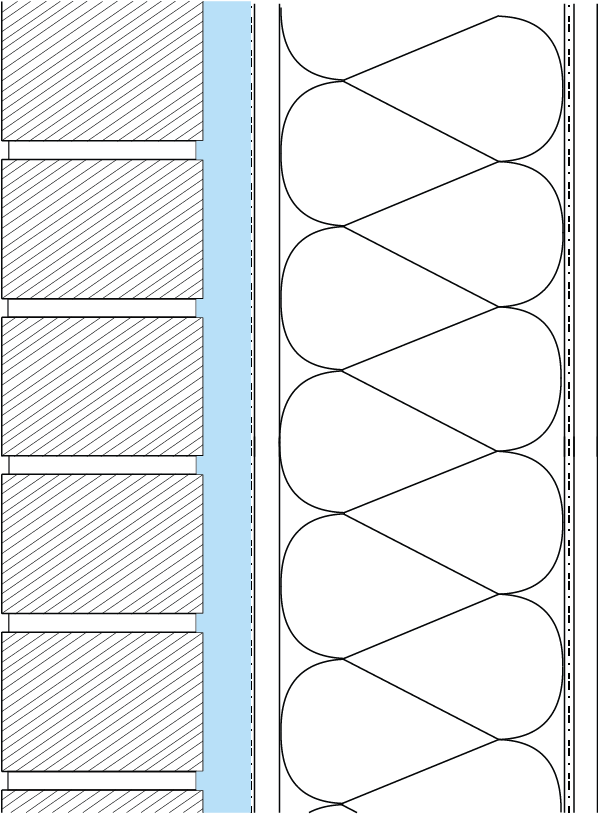
You can read more about Exterior Air Spaces here.
Any material that covers an exterior wall from the outside. In a building envelope, the cladding is identified as the first plane of protection, and acts to protect the layers of the building envelope behind it.
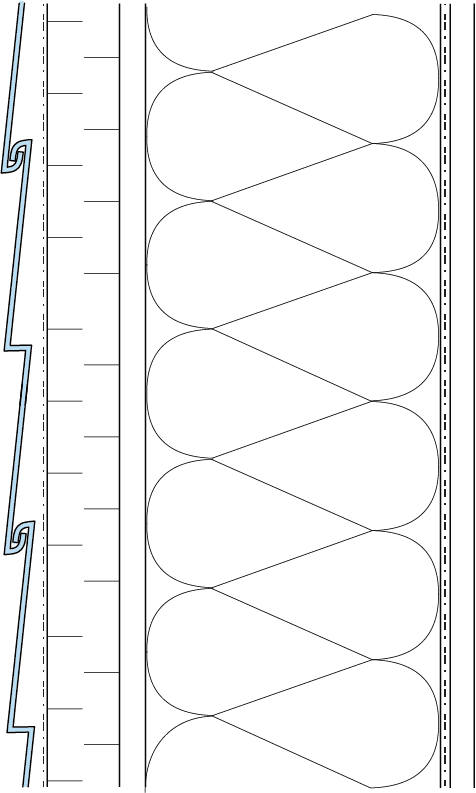
An insulation board formed by extruding chemically dissolved polystyrene beads. XPS is a rigid, lightweight, closed cell, insulating material.
Read more about Extruded Polystyrene here.
An insulation board made of closed-cell plastic used where high insulating capacity is preferred. These boards are also rigid and lightweight. Most often, polyisocyanurate boards are foil faced, meaning that one side of the board is laminated with an aluminum facing which can enhance its thermal performance when the foil faces an air space. This board and its foil face result in an extremely low vapour permeance (significantly less than 60 ng/Pa.s.m2).
Read more about Foil-Faced Polyisocyanurate Board here.
The rough structural timber work of a building, usually consists of graded and stamped dimensional lumber (2x4s, 2x6s, etc.), including the floor joists, roof rafters or joists, interior and exterior wall studs, plates and lintels, ceiling joists, columns, and beams.
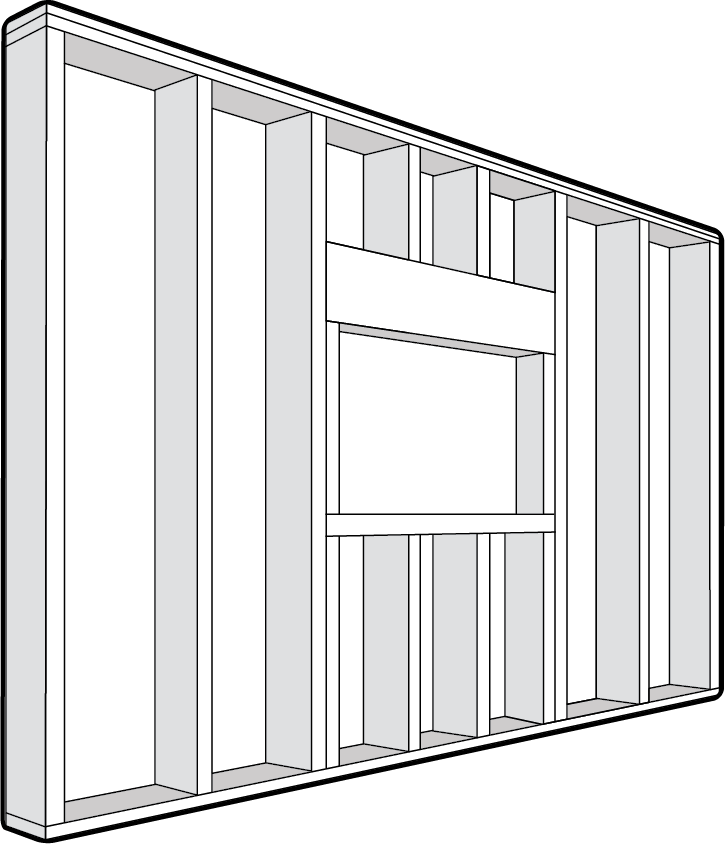
You can read more about Framing here.
Framing Spacing refers to the intervals that studs are located at within the wall framing. The Effective R tool lists stud spacing options of 8 inches (203 mm), 12 inches (305 mm), 16 inches (406 mm), 19.2 inches (488 mm), and 24 inches (610 mm) on centre (o.c.). The most common spacing for studs in wall framing is 16 inches (406 mm) or 24 inches (610 mm) on centre. Stud spacing greater than 24 inches (610 mm) typically requires professional design.
Wood strapping applied to a wall or other surface at regular intervals as support for the interior or exterior finishes, or to add a cavity to accommodate services or to drain rain water to the exterior. Commonly used behind cladding to create a “rain screen” assembly.
Insulation composed of glass fibres that are formed into lightweight batts of uniform thickness. These are one of the most common traditionally used cavity insulations in residential design.
The transfer of energy, in watts (W) or Btu/h, resulting from a temperature difference. It may occur by conduction, convection, radiation or any combination of these.
A sheet material used as a sheathing membrane that is applied to a building exterior to reduce wind infiltration and water ingress. When properly detailed and installed it can also act as an air barrier. Spunbonded Polyolefin (SBPO) is one of the many available house wraps. This synthetic material is highly vapour permeable (much, much greater than 60 ng/Pa.s.m2) but is not permeable to liquid water. In other words, when installed on the outside of the assembly, it does not significantly impede the outward drying of the assembly.
You can read more about House Wrap here.
Installed insulation R value is the same as nominal R value. It only accounts for the thermal resistance of the insulation. See nominal R-value.
A wall component that is used within the building envelope to control the diffusion of water vapour. Sometimes vapour barriers are referred to as vapour retarders. Polyethylene sheet material is the most common residential interior vapour barrier used in Canada.
You can read more about Interior Vapour Barrier here.
Condensation occurring inside an exterior wall or roof assembly. Also sometimes referred to as “concealed condensation”.
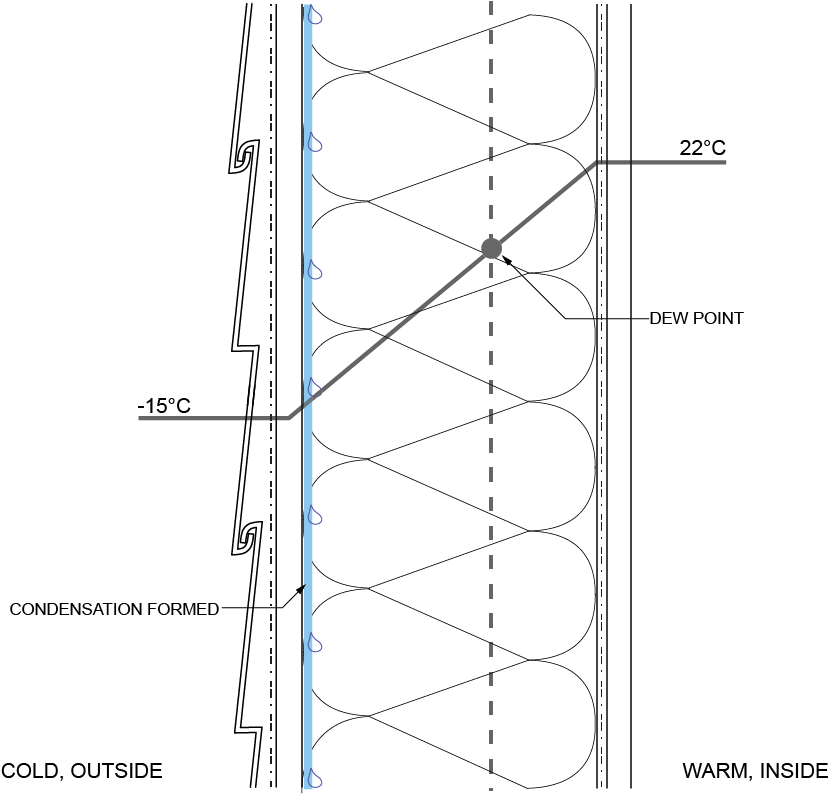
A lapped joint is a joint where the membranes are overlapped at their seams.
Liquid applied water resistive barrier (WRB) is a barrier used as a sheathing membrane, that is either painted or sprayed onto the outside of the wall system to reduce entry of bulk water into the assembly. A liquid applied water resistive barrier is commonly used when installing EIFS. By spraying, painting, or trowelling the water resistive barrier onto the assembly, it is fully and permanently affixed to the assembly.
You can read more about the Liquid Applied WRB here.
An insulating material manufactured from molten slag or rock.
Read more about Mineral Wool here.
Nominal R Value represents the sum of all the thermal resistances associated with the insulation in an assembly. This value does not consider any heat loss from thermal bridging or conductivity of the material in the wall assembly, nor the additional thermal resistance of layers such as plywood sheathing or gypsum board. This value can be seen as a face value estimate for wall thermal performance. It is important to note that the nominal R value may differ significantly from the actual thermal resistance of an assembly that is calculated due to the specific characteristics of the assembly including conductive materials that act as thermal bridges, air spaces and surface air films.
An insulating material made from polyurethane which is sprayed into the building assembly. This material consists of insulating gas "cells" that have not been completely encapsulated in the polyurethane. This results in a softer and more flexible spray insulation, which is typically lower in density than a closed cell spray foam, and higher in water vapour permeability.
An engineered wood-based panel building material most commonly made from aspen or poplar (Canada) or southern yellow pine (US). It is produced by bonding together layers of thin, rectangular-shaped wood strands with strong, water-resistant adhesives under heat and pressure. The surface layer strands are aligned in the long direction of the panel, and the inner layers are oriented randomly or cross aligned perpendicular to the surface layer.
You can read more about Oriented Strand Board (OSB) here.
Materials that are installed towards the outside of the building assembly which are of a low vapour permeance and low air leakage characteristics are considered low permeance materials and must be checked to ensure they do not significantly contribute to cavity moisture problems. The ratio of R-values between all materials outboard of the plane of low air and vapour resistance compared to the R-value of all the materials inboard of that plane must be checked. This only applies when a material installed towards the outside of the building assembly has a low vapour permeance (less than 60 ng/Pa.s.m2) and is considered an air barrier material (less than 0.1 L/(s.m2). The acceptable minimum ratio is dependent on the heating degree days for the location of the construction. See the National Building Code article 9.25.5.2 for additional details.
Application: Outboard to inboard ratio is important to consider when deciding on the materials of a wall assembly to ensure appropriate drying potential towards the outside for the assembly and to ensure the durability of the assembly.
You can read more abot the Outboard to Inboard Ratio here.
A penetration includes any hole or opening in a building assembly that has been made for pipes, wires or other building components to pass through. Openings to accommodate windows and doors are also considered to be penetrations.
Application: It is critical to be aware of penetrations in the assembly. Especially those that penetrate the air barrier. These penetrations must be sealed to ensure that the air barrier is continuous and does not have openings where air can pass through. Proper sealing of penetrations will limit the air leakage of the assembly and contribute to the energy efficiency of the building as well.
The rate at which water vapour diffuses through a material (or assembly between parallel surfaces). It is the mass of water vapour in ng that diffuses through a material driven by one pascal of vapour pressure difference, over second of time, per square meter of surface area. Permeance is measured in ng/Pa.s.m2 in the S.I. system, or perms in the US, where 57 ng/Pa.s.m2 = 1 US perm.
Application: Permeance is important to consider when reviewing materials for the building assembly. The permeance of certain materials will classify them as a vapour barrier material (less than 60 ng/Pa.s.m2), which may be the case for some insulation materials commonly used as exterior insulation. This is important to consider because it can impact the drying potential of the wall assembly and may cause moisture accumulation resulting in the potential for mould growth within the assembly.
The planes of protection are systems within the wall assembly that work together to protect the assembly from liquid water, like rain penetration. The planes of protection must be designed and constructed to minimize the ingress of precipitation that may be caused by water leakage from rain or melting snow and wind driven rain. The first plane of protection is the cladding and is used to handle most of the precipitation load, while the second plane of protection consists of a water resistive barrier that is intended to handle any water that has penetrated past the cladding plane. The second plane allows for the dissipation of the water, usually by gravity drainage and a flashing at the bottom to drain the water out, and provides a barrier to prevent further water ingress to the assembly
Application: Each wall assembly uses the principles of planes of protection to some degree. Some provincial building codes have requirements about first and second planes of protection. Designing assemblies with adequate planes of protection is critical to the durability of the wall assembly.
An engineered wood-based panel building material made from thin sheets of wood veneer bonded under heat and pressure with strong, water-resistant adhesives. Softwood plywood is typically used in wood frame house construction.
You can read more about Plywood here.
A vapour barrier material made of a thin sheet of polyethylene plastic that usually has a very low vapour permeance (less than 60 ng/Pa.s.m2). Commonly used as an interior residential vapour barrier.
You can read more about Polyethylene here.
The term “rainscreen assembly” or “rainscreen system” is typically used to describe assemblies that use three principal layers to control the ingress of water into a wall assembly. The layers are from outside to in:
1. The rain screen layer, designed to intercept incoming water, keeping it out of the assembly. Made of materials which can tolerate being wet, and with deliberate openings to let air pass through, equalizing the cavity pressure with the outdoor air pressure (no pressure difference across this layer).
2. The cavity layer, separating the outer rain screen layer form the inner air barrier layer and providing a capillary break. Flashed at the bottom to drain any water which gets into the cavity back to the outside.
3. The air control layer. Designed to be air tight, and can be a WRB layer in case any moisture does get past the rain screen and cavity layers. Small imperfections can be tolerated as this layer will be mostly dry.
A common example of a rain screen assembly would be horizontal wood siding installed over vertical furring strips over a water resistive barrier layer.
Rainscreen assemblies include both a first and second plane of protection. The cladding is the first plane of protection and it is used to handle most of the precipitation load of the assembly. The second layer is used to handle any water that penetrates the cladding.
Sheathing membranes are sheet materials (such as asphalt impregnated paper, spun bonded polyolefin (house wrap) or other materials) that are installed as a component of the exterior walls of a building to protect against rain and wind entry. Sheathing membranes are often referred to as water-resistive barriers.
You can read more about Sheathing Membranes here.
A common building component that is used as an exterior wall covering or cladding. Siding is typically considered a non-absorptive and rain shedding cladding material.
Read more about siding here.
Simulated durability analysis is a type of analysis used to predict the durability of a wall assembly in a given climate area. This type of analysis uses a combination of hygrothermal computer modelling and field experience to produce an analysis. The assemblies are simulated using a variety of assumptions related to, but not limited to, assembly orientation, location, rain load, surface transfer coefficients, initial conditions, simulation duration, outdoor climate, indoor climate, and material properties.
Application: simulated durability analysis can be used to predict how a wall assembly might behave in a particular climate to predict their durability. It is a good way to test out the material properties of different elements of the assembly in terms of how their permeance and moisture control properties affect the performance of the whole assembly.
You can read more about Simulated Durability Analysis here.
Smart Vapour Retarders, or variable permeance retarders, consist of a nylon material that becomes more permeable as the relativity humidity that it is exposed to increases. Where the wall cavity is relatively dry, like in the wintertime, it acts as a traditional vapour barrier. When there is more moisture in the assembly, like in the summer, a smart vapour retarder may facilitate the drying of a cavity to the inside when vapour flow is outside to inside.
You can read more about Smart Vapour Retarders here.
Solar driven moisture is a moisture transfer mechanism which happens when a porous cladding capable of absorbing and storing water (such as a brick veneer or wood siding) becomes wet due to a rain event, and then the sun shines on the wall cladding, heating it up often up to over 40°C above the ambient air temperature, resulting in very high vapour pressures within the porous cladding, which then drives the water vapour into the wall. This phenomenon is most common on east and west elevations as these receive the maximum solar exposure in the summer. Some common methods for avoiding this phenomenon involve using non-absorptive claddings such as vinyl siding or non-absorptive treatments on wood siding, by providing a well vented cavity vented to the outside behind brick veneers and other absorptive claddings, or by providing shading to east and west facing walls.
Application: Solar driven moisture can contribute to mould development and deterioration of framing materials due to rot within the wall cavity. The use of interior polyethylene vapour retarders and exterior sheathing and membranes that are more vapour permeable may contribute to this problem, as the interior polyethylene prevents the wall’s ability to dry to the inside while the exterior sheathings and house wraps allow more water vapour to enter the cavity. This may not be a problem for all buildings, but it is an important phenomenon to consider.
You can read more about Solar Driven Moisture here.
Plywood or oriented strand board (OSB) that is used to cover the exterior frame of a building are examples of structural wood sheathing. Exterior wood sheathing provides walls with structural resistance to lateral loads like those from wind and earthquakes, and wind uplift resistance if installed across assemblies. Structural sheathing also provides a nailing substrate for cladding materials including various sidings. A 2014 report by NRC also showed that walls with wood sheathing are less likely to have moisture issues than walls without due to the higher moisture storage capacity of the wood sheathing layer compared to that of a plastic insulation layer.
You can read more about Structural Wood Sheathing here.
Surface film coefficients are used to account for the radiative, conductive and convective heat transfer modes at the exterior and interior surfaces of building components. A surface film is a layer of still air next to the solid surface of an assembly and is included in the thermal resistance calculations of the assembly. The resistance to heat flow at a surface is small relative to the heat flow of a typical modern wall.
Surface film coefficients are different for interior and exterior wall surfaces and should be considered when calculating the total thermal resistance of a wall assembly.
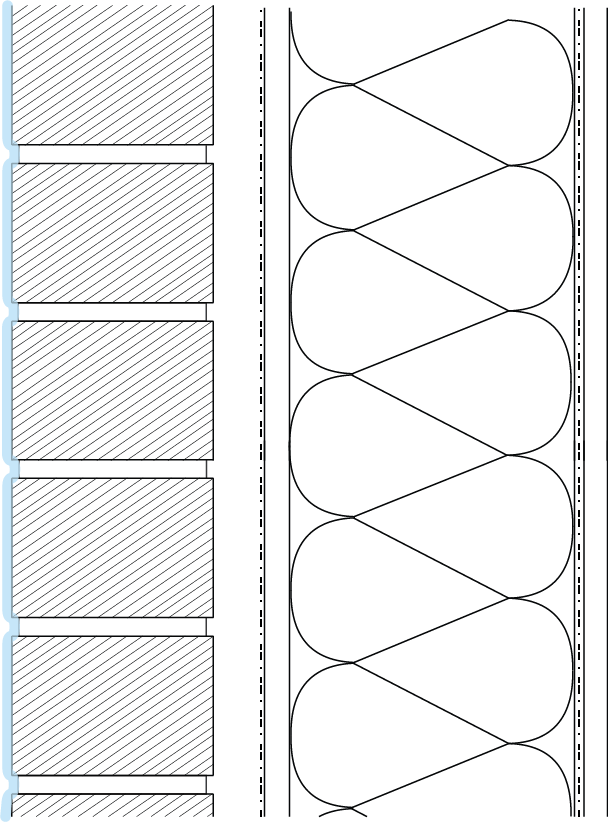
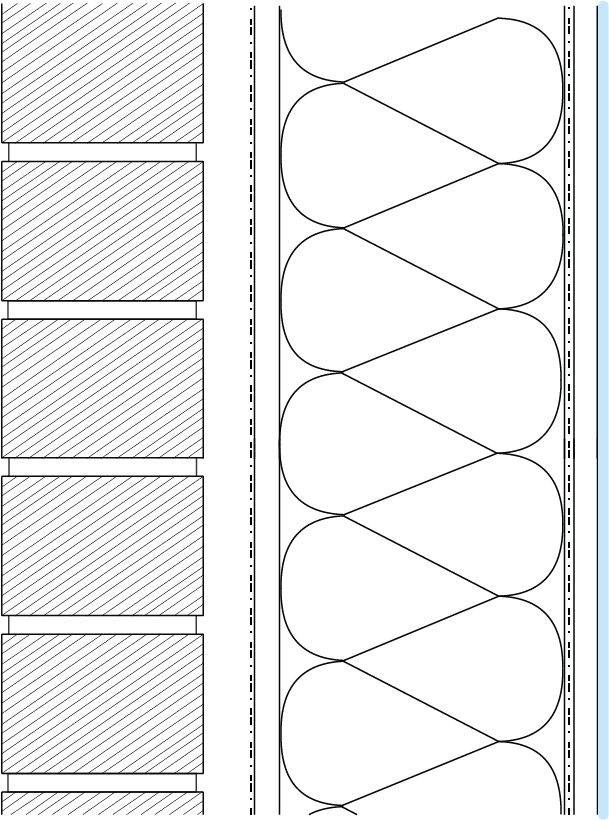
Exterior Surface Film Interior Surface Film
A component, assembly or area of the building envelope that has noticeably higher thermal conductivity (lower thermal resistance) than the surrounding area. Examples include metal window frames, continuous balcony slabs, and steel studs. Depending on the size of the thermal bridge (or bridges) and its thermal conductivity, a reduction in the overall thermal insulation value of the envelope can result. Thermal bridges can cause higher heat loss, increased space heating energy consumption, comfort problems and condensation related moisture problems.
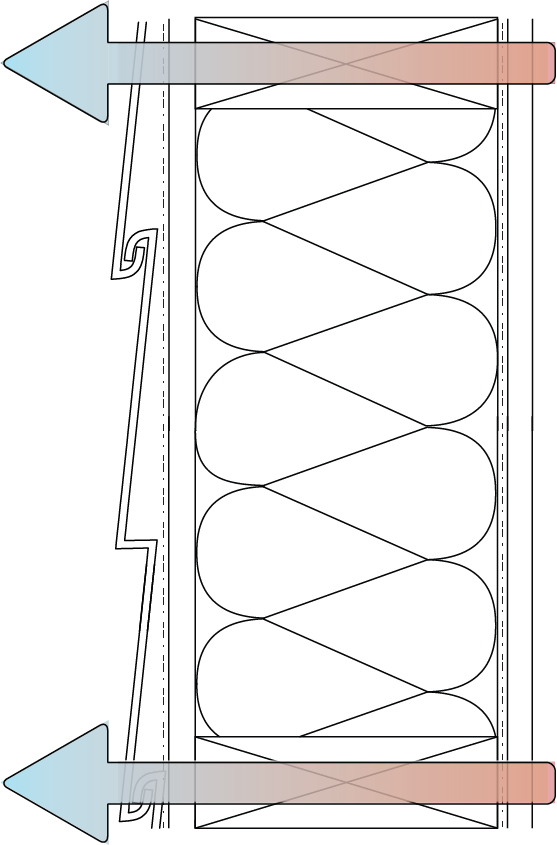
Application: Understanding thermal bridging is necessary to determine the effective thermal resistance of an assembly, and how well a wall assembly will actually perform. Different material components have different thermal resistances which affect how well they are able to resist the transfer of heat. A wall assembly with cavity insulation and no external insulation can experience thermal bridging through the wood studs. Wood studs have a lower thermal resistance when compared to the cavity insulation so they facilitate heat transfer. A solution for this would be to install continuous exterior insulation on the outside of the assembly to reduce the amount of thermal bridging.
Thermal resistance is the resistance of a material or assembly to heat flow, and is reciprocal of thermal conductance. Metric units are m2K/W. It indicates the ability of a material to resist heat transfer and is often used to characterize insulation materials.
RSI is used as the abbreviation for resistance system international. This is the coefficient of thermal resistance expressed in metric units. R is the coefficient of thermal resistance expressed in imperial units.
Typically used for tall wall construction, or midrise buildings. As the height of the wall increases, or the number of supported floors increase, the studs must be paired together to resist the higher loads.
You can read more about Twinned Studs here.
A paint coating that has a specified vapour permeance not greater than 60 ng/Pa.s.m2 that controls the passage of water vapour by diffusion. Compared to polyethylene, which has a vapour permeance of almost 0 ng/Pa.s.m2, vapour retarder paint could allow for better drying potential towards the inside. The vapour retarder paint would be applied onto the room side of the gypsum board according to Building Code. This is a less common vapour control approach when compared to polyethylene. Check with the local municipality to ensure that they are familiar with the material. It is important to follow the manufacturer’s instructions when using vapour retarder paint; in particular the minimum number of coats required to provide the expected vapour control. The application thickness as a result of the painting method is also to be considered.
Depending on how much air is allowed to circulate in the air space behind the cladding layer of a wall assembly, an air space can be categorized as vented or ventilated. Vented air spaces typically have openings such as weep holes only at the bottom of the assembly, whereas ventilated air spaces have both openings at the bottom of the cladding and at the top of the wall. Vented air spaces are most common in low rise housing. These have limited air circulation and serve primarily as a drainage plane and capillary break. Ventilated air spaces, on the other hand, are designed to allow much more air to circulate in the space due to openings both at the bottom and the top of the assembly, allowing the space to not only act as a drainage plane and capillary break, but also as a space that allows moisture to be dissipated to the outside air. Ventilated air spaces often use furring or strapping to create deeper, circulating air spaces.
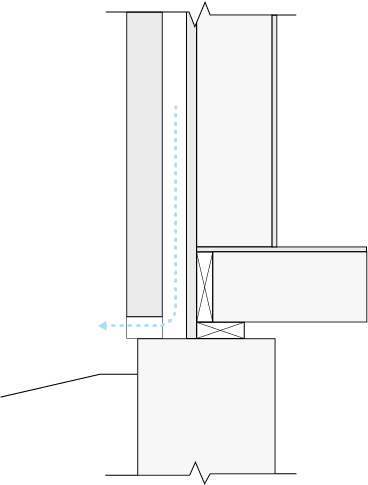
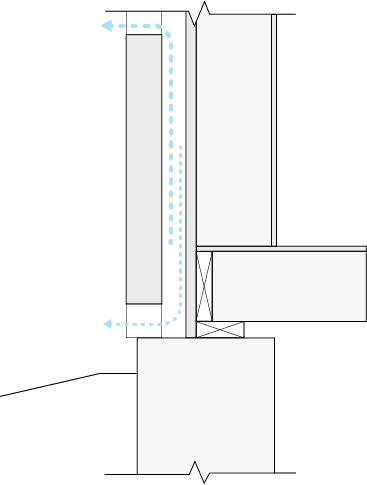
Vented Air Space Ventilated Air Space
Water vapour diffusion is a moisture transport mechanism driven by a vapour pressure gradient (a vapour pressure gradient can also be thought of as a “water molecule concentration gradient”). The rate of water vapour diffusion through a porous material is determined by a water vapour pressure gradient (or water vapour molecule concentration gradient) from one side to the other side of the material, and the permeance of the material given in “perms” in the U.S. or ng/pa.s.m2 in Canada (1 perm = 57 ng/pa.s.m2). The greater the water vapour pressure gradient, the greater the rate of diffusion. The greater the permeance, the greater the rate of diffusion.
A type of building construction where the structural elements are made out of wood members. These can include, wood studs, joists, rafters and trusses. Wood-frame construction is often used for low-rise and mid-rise residential construction.